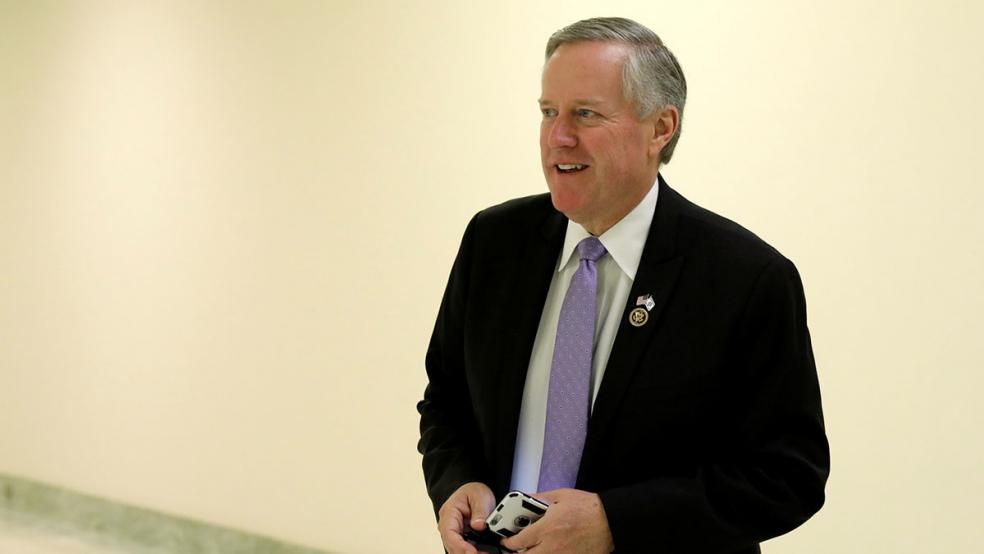Rep. Mark Meadows, R-NC, one of the most influential conservatives in the House, said Monday he favors quick action this summer to raise the debt ceiling, taking a stand on an issue that is threatening to divide the GOP and raise the risk of a first-ever default on U.S. borrowing later this fall.
Meadows, chair of the far-right House Freedom Caucus, said in an interview it would be a mistake to postpone action on authorizing increased borrowing authority for the Treasury. He argued that the White House and Republican congressional leaders have no choice but to undertake the politically odious task and should do it now instead of allowing it to become greatly complicated by controversial budget and spending issues in late September or early October.
Freedom Caucus Fires First Volley in New Debt Ceiling Battle
Meadows said that he and the nearly 40 other members of the Freedom Caucus had taken an official position that “we believe that we need to go ahead and act in July – get it off the table . . . and make a decision right away.”
The federal government in mid-March reached its legal borrowing limit. Ever since then, the Treasury has resorted to a series of “extraordinary measures” to avoid issuing any securities that would breach the legal debt ceiling limit. This painstaking process by Treasury officials has involved postponing certain payments other than to lenders and shifting federal accounts around.
Meadows, the leader of arguably the most potent faction within the House GOP caucus, seemingly sided with Treasury Secretary Steven Mnuchin who for months has urged Congress to raise the $19.9 trillion debt ceiling before the August recess to reduce the possibility of a catastrophic default on borrowing. The former Wall Street financier has also demanded that Congress pass a “clean” debt ceiling legislation, free of any controversial amendments.
By contrast, Office of Management and Budget Director Mick Mulvaney, a former South Carolina Republican House member and co-founder of the Freedom Caucus, insists the administration and congressional Republicans can wait until this fall to address the debt ceiling to use it as a bargaining chip in dealing with the Democrats and recalcitrant Republicans.
Related: White House's Debt Ceiling Battle Could Trigger a Shutdown — and Recession
Meadows agrees with Mulvaney that new debt ceiling legislation should double as a budgetary vehicle for reducing spending and advancing the GOP agenda. But rather than complicating the issue this fall with a battle over defense and domestic spending, mandatory programs and possibly even a tax cut, Meadows and his conservative colleagues are advancing a small handful of amendments to be considered this summer as part of new debt ceiling legislation.
“We’ve never done a ‘clean’ debt ceiling before,” Meadows said, following a speech to the National Press Club. “So now you have a Republican Congress and a Republican in the White House, and all of a sudden [some are calling for] a clean debt ceiling. I don’t think so.”
“But we can do something that’s close to clean, and maybe structure reform.” he added.
Related: Mulvaney's Debt Ceiling Ploy Protects Treasurys, Not Social Security
One of three proposals under consideration would invite the administration to “prioritize” U.S. debt and withhold some payments to creditors and government agencies and programs if Congress reaches an impasse on spending and faces a possible default and government shutdown.
A bill recently introduced by Freedom Caucus members – and roundly endorsed by Mulvaney – would require the government to prioritize payments to holders of public debt, even to the point of mandating the sale of GDP-linked bonds to fund the payment of principal and interest. The bill would also authorize the president “to request the rescission of certain unobligated balances and sell certain mortgage-related assets, and for other purposes.”
The underlying premise of the legislation is that as long as the government doesn’t default on its Treasury securities, it will not be treated by future lenders as if the Treasury had failed to meet its obligations – even if the government fails to pay other creditors or government agencies and programs.
Meadows and his caucus have two other backup ideas if their debt prioritization plan fizzles: One would attempt to link the debt ceiling to $250 billion of additional spending cuts in the fiscal 2018 budget resolution. The other would make new debt ceiling legislation conditional on the repeal and replacement of the Affordable Care Act – a matter likely to be considered by the Senate this week.
“That’s as close to a clean debt ceiling as I think we could stomach,” Meadows said. “But it’s more policy than it is financial.”





